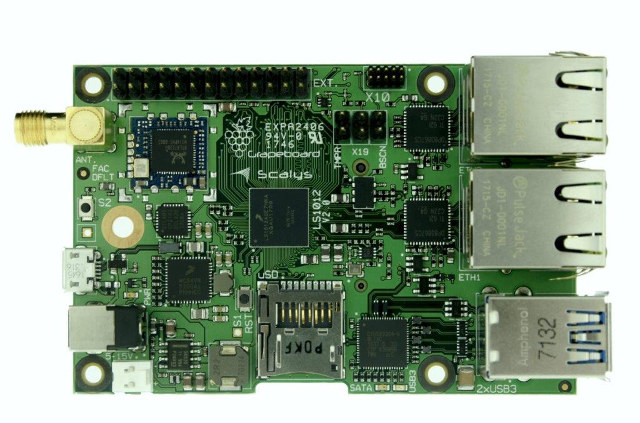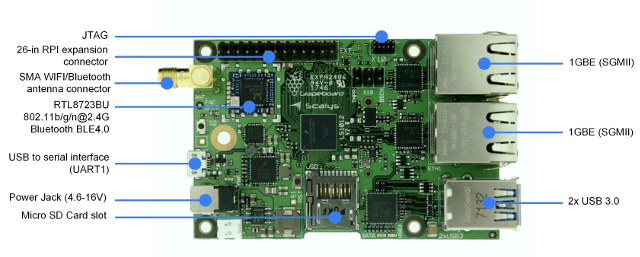Scalys is a startup founded in 2016 in the Netherlands by Sintecs in order to provide advanced high-performance embedded system solutions for automotive-, avionics-, defence-, industrial-, medical and telecommunication industries. So the company is rather new, but if you visit their website, you’ll find they already have several systems-on-module and single board computers (SBCs) based on NXP QorIQ processors.
Grapeboard SBC is their latest product powered by NXP QorIQ LS1012A (LayerScape 1012A) single core SoC with 1GB RAM, and equipped with two Gigabit Ethernet interfaces, two USB 3.0 ports, an M.2 SATA connector, etc… that make it suitable for IoT applications such as sensor/IoT gateways, communication hubs, and secure edge devices.

GrapeBoard specifications:
- SoC – NXP QorIQ LS1012A single core Cortex A53 processor @ up to 800 MHz with Packet Forwarding Engine
- System Memory – 1GB DDR3
- Storage
- 64Mb (8MB) SPI NOR Flash for BCD and bootloader,
- 512Mb/64MB SPI NOR Flash for u-boot and Linux kernel
- micro SD card slot
- Connectivity
- 2x Gigabit Ethernet ports
- 802.11 b/g/n WiFi and Bluetooth 4.0 LE via Realtek RTK8723BU module; SMA antenna connector
- USB – 2x USB 3.0 ports
- Expansion
- 26-pin Raspberry Pi expansion connector
- M.2 connector with SATA, PCIe, and USB 2.0/3.0 (multiplexed)
- Debugging – JTAG header, micro USB port for serial console
- Security – Integrated security engine (SEC), QorIQ Trust Architecture, Arm TrustZone
- Power Supply – 4.5 to 16V DC input via power barrel jack
- Dimensions – 85.60 x 56mm (est. based on Raspberry Pi board dimensions)

The board is supposed to run Linux, and we do not know availability nor pricing information right now, as the website setup for the board has very limited information at this stage. However, we may soon find out more, as LinuxGizmos reports Scalys will showcase the board at CES 2018 in less than two weeks.

Jean-Luc started CNX Software in 2010 as a part-time endeavor, before quitting his job as a software engineering manager, and starting to write daily news, and reviews full time later in 2011.
Support CNX Software! Donate via cryptocurrencies, become a Patron on Patreon, or purchase goods on Amazon or Aliexpress





At last a board designed for I/O! Certain parts of the design make it look serious. The wide range input power supply over the jack is pretty cool. The embedded USB UART is nice, like you find on most Marvell boards. Having the PCIe/mSATA and USB3 can make it trivial to build pocket-size inline network sniffers. Those who want to build their own NAS will also appreciate the GigE+USB3+SATA. The CPU may be a bit limited for certain use cases though. Let’s wait for the price. Maybe at least it can wake up some other board designers regarding the need for more I/O.
Nice, indeed! I just wish that the MicroUSB connection was directly connected to the CPU, rather than through a USB-UART chip, so it could be different personalities.
At $18-20 a pop per SoC, this is not going to be a cheap board. Why is it that NXP/Freescale always have such retarded pricing for their parts? It makes them unattractive to just about anyone except industrial or medical verticals.
The FreedomFRDM-LS1012A has been around for while at $49 which is a good route for evaluating the LS1012A.
An alternative would be Espressobin (Marvell Armada 3700LP) although I have no experience with it.
@TLS
where did u get that price from ?
is it specific to the network socs NXP offers or is the 8xm the same too ?
“At last a board designed for I/O!” – Have you looked at the BeagleBone Black? Very much IO centric …. and around long eneough to have a community and support, which is an issue with various “me too” arm stuff…
I would want to build a firewall with one of these, but a single core at 800mhz? That’s pathetic. You need at least two, preferably three, cores so that one can be the management plane, another for packet inspection and forwarding, and a third to do IDS/IPS/AV type analysis.
Also what about this so-called “Packet Forwarding Engine”? How many open source firewalls even support such custom hardware? This reminds me of the custom DSP chip in the old NeXT computer. No one used it.
Let me know when these guys release a quad-core board.
Nice board in may ways but maybe I’m jaded but why ever bother with a SBC, with Linux in mind, and saddle it with a single core processor? Especially an ARM core which isn’t a huge demand upon die space.
In any event not exactly what I’m looking for. All current ideas that I have in the back of my head demand a good enough GPU. I case you are wondering good enough to run a Linux GUI to support a CNC machine interface. In other words embedded controllers.
@bantoto masabo sigola
Digi-Key, mouser etc. all charge around that, although admittedly neither seems to have more than 500 units in stock, so the price is a bit skewed because of that. Note that this is for the cheapest 800MHz part though.
@anyone
dont forget that this comes with a packet accelerator
netgate has the SG-1000 that uses an old cortex A8 at 600mhz and its performance is quite good
https://www.reddit.com/r/PFSENSE/comments/556yhc/sg1000_ufw_performance_tests/
Yes, I have one. I already used it as a JTAG probe as its GPIOs are very fast and it allowed me to reflash a dockstar pretty quickly. It has PWMs and everything needed to manage motors, relays, sensors. When your I/Os are more data-centric (network, storage) the BBB is totally irrelevant however.
Via G+.. The packet forwarding engine (PFE) is handled by a binary blob, and NXP does not provide technical details:
Source: https://community.nxp.com/thread/447835
I’m afraid that it won’t be cheap, not as cheap as Marvell commercial solution at least.
Even NXP marketing guy told me that they were not good at making low cost stuff.
I was looking at 64-bit ARM SoC for network management and found a dual core NXP QorIQ SoC would cost $40. Can’t image the PCBA cost.